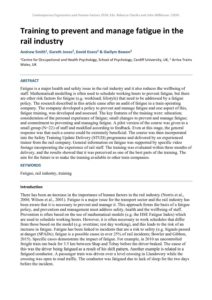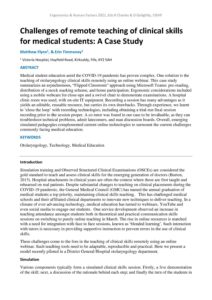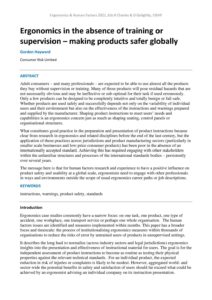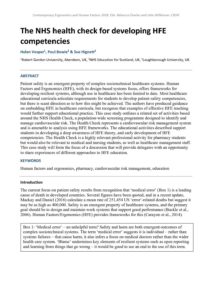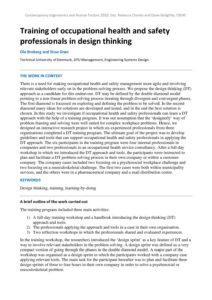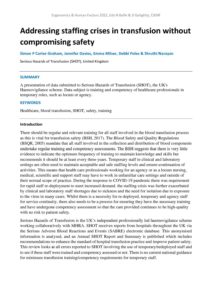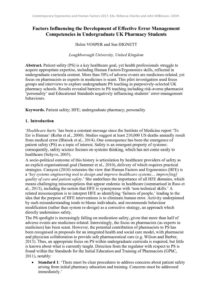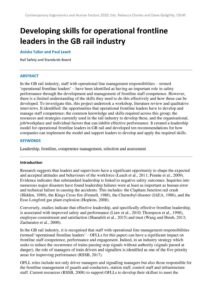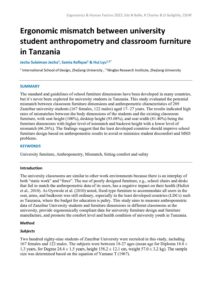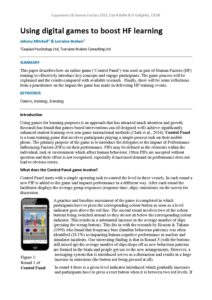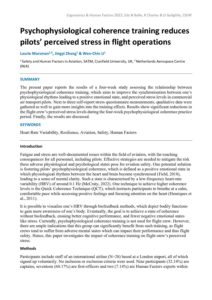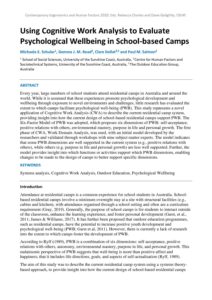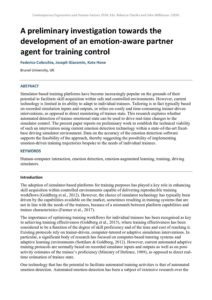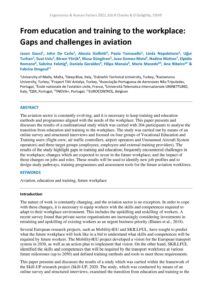Education, training & skills
Training to prevent and manage fatigue in the rail industry
| Document | Author Andrew Smith, Gareth Jones, David Evans & Gwilym Bowen |
| Abstract Fatigue is a major health and safety issue in the rail industry and it also reduces the wellbeing of staff. Mathematical modelling is often used to schedule working hours to prevent fatigue, but there are other risk factors for fatigue (e.g. workload; lifestyle) that need to be addressed by a fatigue policy. The research described in this article came after an audit of fatigue in a train operating company. The company developed a policy to prevent and manage fatigue and one aspect of this, fatigue training, was developed and assessed. The key features of the training were: education; consideration of the personal experience of fatigue; small changes to prevent and manage fatigue; and commitment to preventing and managing fatigue. A pilot version of the course was given to a small group (N=22) of staff and modified according to feedback. Even at this stage, the general response was that such a course could be extremely beneficial. The course was then incorporated into the Safety Training Update Delivery (STUD) programme and delivered by an experienced trainer from the rail company. General information on fatigue was supported by specific video footage incorporating the experience of rail staff. The training was evaluated within three months of delivery, and the results showed that it was perceived as one of the best parts of the training. The aim for the future is to make the training available to other train companies. |
Challenges of remote teaching of clinical skills for medical students: A Case Study
| Document | Author Matthew Flynn & Erin Timmoney |
| Abstract Medical student education amid the COVID-19 pandemic has proven complex. One solution is the teaching of otolaryngology clinical skills remotely using an online webinar. This case study summarizes an asynchronous, “Flipped Classroom” approach using Microsoft Teams: pre-reading, distribution of a mock marking scheme, and home participation. Ergonomic considerations included using a mobile webcam for close-ups and a swivel chair to demonstrate examinations. A hospital clinic room was used, with on-site IT equipment. Recording a session has many advantages as it yields an editable, reusable resource, but carries its own drawbacks. Through experience, we learnt to ‘close the loop’ with recording technologies, including obtaining a trial-run final session recording prior to the session proper. A co-tutor was found in our case to be invaluable, as they can troubleshoot technical problems, admit latecomers, and man discussion boards. Overall, emerging simulated pedagogies complemented current online technologies to surmount the current challenges commonly facing medical education. |
Lessons in the Metaverse: Teaching University students about Virtual Reality from within Virtual Reality
| Document | Author Gary Burnett & Catherine Harvey |
| Abstract There is considerable potential in the education sector for the use of immersive virtual worlds to enhance student learning and engagement. This paper outlines five key recommendations for teaching University students in future ‘Metaverse’ contexts. These guidelines are based on video/survey data collected from 266 students during a module that has run predominately in virtual reality for the last three years, as well as the reflective experiences of the teachers. |
Ergonomics in the absence of training or supervision – making products safer globally
| Document | Author Gordon Hayward |
| Abstract Adult consumers – and many professionals – are expected to be able to use almost all the products they buy without supervision or training. Many of those products will pose residual hazards that are not necessarily obvious and may be ineffective or sub-optimal for their task if used erroneously. Only a few products can be designed to be completely intuitive and totally benign or fail-safe. Whether products are used safely and successfully depends not only on the variability of individual users and their environment but also on the effectiveness of the instructions and warnings prepared and supplied by the manufacturer. Shaping product instructions to meet users’ needs and capabilities is an ergonomics concern just as much as shaping seating, control panels or organisational structures. What constitutes good practice in the preparation and presentation of product instructions became clear from research in ergonomics and related disciplines before the end of the last century, but the application of these practices across jurisdictions and product manufacturing sectors (particularly in smaller scale businesses and low-price consumer products) has been poor in the absence of an internationally accepted standard. Achieving this has required engaging with other stakeholders within the unfamiliar structures and processes of the international standards bodies – persistently over several years. The message here is that for human factors research and experience to have a positive influence on product safety and usability at a global scale, ergonomists need to engage with other professionals in ways and environments outside the scope of usual ergonomics career paths or job descriptions. |
The NHS health check for developing HFE competencies
| Document | Author Helen Vosper, Paul Bowie & Sue Hignett |
| Abstract Patient safety is an emergent property of complex sociotechnical healthcare systems. Human Factors and Ergonomics (HFE), with its design-based systems focus, offers frameworks for developing resilient systems, although use in healthcare has been limited to date. Most healthcare educational curricula articulate requirements for students to develop patient safety competencies, but there is scant direction as to how this might be achieved. The authors have produced guidance on embedding HFE in healthcare curricula, but recognise that examples of effective HFE teaching would further support educational practice. This case study outlines a related set of activities based around the NHS Health Check, a population-wide screening programme designed to identify and manage cardiovascular risk. The Health Check represents a cardiovascular risk management system and is amenable to analysis using HFE frameworks. The educational activities described support students in developing a deep awareness of HFE theory, and early development of HFE competencies. The Health Check is a highly relevant professional activity for pharmacy students but would also be relevant to medical and nursing students, as well as healthcare management staff. This case study will form the focus of a discussion that will provide delegates with an opportunity to share experiences of different approaches to HFE education. |
Training of occupational health and safety professionals in design thinking
| Document | Author Ole Broberg and Sisse Grøn |
| Abstract There is a need for making occupational health and safety management more agile and involving relevant stakeholders early on in the problem-solving process. We propose the design thinking (DT) approach as a candidate for this endeavour. DT may be defined by the double diamond model pointing to a non-linear problem-solving process iterating through divergent and convergent phases. The first diamond is focussed on exploring and defining the problem to be solved. In the second diamond many ideas for solutions are developed and tested, and in the end the best solution is chosen. In this study we investigate if occupational health and safety professionals can learn a DT approach with the help of a training program. It was our assumption that the ‘designerly’ way of problem framing and solving were well suited for complex workplace problems. Hence, we designed an interactive research project in which six experienced professionals from three organisations completed a DT training program. The ultimate goal of the project was to develop guidelines and tools that can support occupational health and safety professionals in applying the DT approach. The six participants in the training program were four internal professionals in companies and two professionals in an occupational health service consultancy. After a full-day workshop in which we introduced the DT approach and tools, the participants were instructed to plan and facilitate a DT problem-solving process in their own company or within a customer company. The company cases included two focusing on a psychosocial workplace challenge and two focusing on a musculoskeletal challenge. The first two cases were both within municipality services, and the others were in a pharmaceutical company and a mail distribution centre. |
Exploratory study of virtual reality flight training device for upset prevention and recovery training
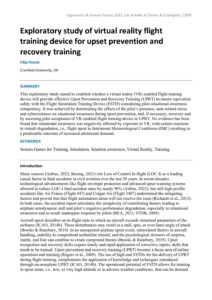
| Document
Insert here |
Author Filip Florek |
| Abstract This exploratory study aimed to establish whether a virtual reality (VR) enabled flight training device will provide effective Upset Prevention and Recovery Training (UPRT) to ensure equivalent safety with the Flight Simulation Training Device (FSTD) considering pilot situational awareness competency. It was achieved by determining the effects of the pilot’s presence, task-related stress and cybersickness on situational awareness during upset prevention, and, if necessary, recovery and by assessing pilot acceptance of VR-enabled flight training device in UPRT. No evidence has been found that situational awareness was negatively affected by exposure to VR, with certain reactions to stimuli degradation, i.e., flight upset in Instrument Meteorological Conditions (IMC) resulting in a predictable outcome of increased attentional demand. |
An Online Manual Handling Toolkit to Improve Skills and Reduce Risks
| Document | Author Jo-anne WEBB, Deborah HARRISON, Katy SZCZEPURA |
| Abstract |
Smart-learning: home-workplace effect on (dis)comfort and lessons effectiveness during Covid-19 lockdown
Addressing staffing crises in transfusion without compromising safety
| Document | Author Simon P Carter-Graham, Jennifer Davies, Emma Milser, Debbi Poles & Shruthi Narayan |
| Abstract A presentation of data submitted to Serious Hazards of Transfusion (SHOT), the UK's Haemovigilance scheme. Data subject is training and competency of healthcare professionals in temporary roles, such as locum or agency. |
Factors Influencing the Development of Effective Error Management Competencies in Undergraduate UK Pharmacy Students
| Document | Author Helen VOSPER and Sue HIGNETT |
| Abstract Patient safety (PS) is a key healthcare goal, yet health professionals struggle to acquire appropriate expertise, including Human Factors/Ergonomics skills, reflected in undergraduate curricula content. More than 50% of adverse events are medicines-related, yet focus on pharmacists as experts in medicines is scant. This pilot investigation used focus groups and interviews to explore undergraduate PS teaching in purposively-selected UK pharmacy schools. Results revealed barriers to PS teaching including risk-averse pharmacist ‘personality’ and Educational Standards negatively influencing students’ error-management behaviours. |
Developing skills for operational frontline leaders in the GB rail industry
| Document | Author Anisha Tailor and Paul Leach |
| Abstract In the GB rail industry, staff with operational line management responsibilities – termed ‘operational frontline leaders’ – have been identified as having an important role in safety performance through the development and management of frontline staff competence. However, there is a limited understanding of the skills they need to do this effectively and how these can be developed. To investigate this, this project undertook a workshop, literature review and qualitative interviews. It identified: the opportunities that operational frontline leaders have to develop and manage staff competence; the common knowledge and skills required across this group; the resources and strategies currently used in the rail industry to develop these, and the organisational, job/workplace and individual factors that can inhibit effective performance. It created a leadership model for operational frontline leaders in GB rail and developed ten recommendations for how companies can implement the model and support leaders to develop and apply the required skills. |
Ergonomic mismatch between university student anthropometry and classroom furniture in Tanzania
| Document | Author Jecha Suleiman Jecha, Samia Rafique & Hui Lyu |
| Abstract The standard and guidelines of school furniture dimensions have been developed in many countries, but it’s never been explored for university students in Tanzania. This study evaluated the potential mismatch between classroom furniture dimensions and anthropometric characteristics of 289 Zanzibar university students (167 females, 122 males) aged 17- 27 years. The results indicated high rates of mismatches between the body dimensions of the students and the existing classroom furniture, with seat height (100%), desktop height (93.08%), and seat width (81.40%) being the furniture dimensions with higher level of mismatch and backrest height with a lower level of mismatch (66.26%). The findings suggest that the least developed countries should improve school furniture design based on anthropometric results to avoid or minimize student discomfort and MSD problems. |
Using digital games to boost HF learning
| Document | Author Johnny Mitchell & Lorraine Braben |
| Abstract This paper describes how an online game (‘Control Panel’) was used as part of Human Factors (HF) training to effectively introduce key concepts and engage participants. The game process will be explained and the results compared with available research. Finally, there will be some reflections from a practitioner on the impact the game has made in delivering HF training events. |
Psychophysiological coherence training reduces pilots’ perceived stress in flight operations
| Document | Author Laurie Marsman, Jingyi Zhang & Wen-Chin Li |
| Abstract The present paper reports the results of a four-week study assessing the relationship between psychophysiological coherence training, which aims to improve the synchronisation between one’s physiological rhythms leading to a positive emotional state, and perceived stress levels in commercial air transport pilots. Next to three self-report stress questionnaire measurements, qualitative data were gathered as well to gain more insights into the training effects. Results show significant reductions in the flight crew’s perceived stress levels during the four-week psychophysiological coherence practice period. Finally, the results are discussed. |
Using Cognitive Work Analysis to Evaluate Psychological Wellbeing in School-based Camps
| Document | Author Michaela E. Schuler, Gemma J. M. Read, Clare Dallat and Paul M. Salmon |
| Abstract Every year, large numbers of school students attend residential camps in Australia and around the world. While it is assumed that these experiences promote psychological development and wellbeing through exposure to novel environments and challenges, little research has evaluated the extent to which camps facilitate psychological well-being (PWB). This study represents a novel application of Cognitive Work Analysis (CWA) to describe the current residential camp system, providing insight into how the current design of school-based residential camps support PWB. The Six-Factor Model of PWB was adopted, which proposes six dimensions of PWB: self-acceptance, positive relations with others, environmental mastery, purpose in life and personal growth. The first phase of CWA, Work Domain Analysis, was used, with an initial model developed by the researchers and validated through workshops with nine subject matter experts. The model indicates that some PWB dimensions are well supported in the current system (e.g., positive relations with others), while others (e.g. purpose in life and personal growth) are less well supported. Further, the model provides insight into which functions or activities support which PWB dimensions, enabling changes to be made to the design of camps to better support specific dimensions. |
A preliminary investigation towards the development of an emotion-aware partner agent for training control
| Document | Author Federico Colecchia, Joseph Giacomin, Kate Hone |
| Abstract Simulator-based training platforms have become increasingly popular on the grounds of their potential to facilitate skill acquisition within safe and controlled environments. However, current technology is limited in its ability to adapt to individual trainees. Tailoring is in fact typically based on recorded simulation inputs and outputs, or relies on costly and time-consuming trainer-driven interventions, as opposed to direct monitoring of trainee state. This research explores whether automated detection of trainee emotional state can be used to drive real-time changes to the simulator control. The present paper reports on preliminary work to establish the technical viability of such an intervention using current emotion detection technology within a state-of-the-art fixed-base driving simulator environment. Data on the accuracy of the emotion detection software supports the feasibility of the approach, thereby suggesting the possibility of implementing emotion-driven training trajectories bespoke to the needs of individual trainees. |
Teaching Triangulation in Ergonomics
| Document | Author David HITCHCOCK, Felix SCHMID |
| Abstract The Railway Risk and Safety Management MSc programme, offered by the Universities of Birmingham and York, includes a week long module ‘Practical Ergonomics for Railway Systems (PERS)’. Through this module, the course team seeks to impart knowledge about ergonomics and human factors and to develop in students a holistic understanding of the role and approaches of ergonomists. Students from Europe and overseas, both part and full-time, with a variety of experiences and from different cultures, engage in a module that is intentionally designed to balance theory of ergonomics with its application to practical problems. This paper, discusses the reasoning behind the module design and the purpose of the components included. |
From education and training to the workplace: Gaps and challenges in aviation
| Document | Author Jason Gauci, John De Carlo, Alessia Golfetti, Paola Tomasello, Linda Napoletano, Uğur Turhan, Suat Uslu, Birsen Yörük, Musa Güngören, Joao Gomes-Mota, Nadine Matton, Elpidio Romano, Sabrina Feletig, Daniela Geraldes, Filipa Manaia, Maria Macedo, Ana Ribeiro & Fabrice Drogoul |
| Abstract The aviation sector is constantly evolving, and it is necessary to keep training and education methods and programmes aligned with the needs of the workplace. This paper presents and discusses the results of a multinational study which was carried with 204 participants to analyse the transition from education and training to the workplace. The study was carried out by means of an online survey and structured interviews and focused on four groups of Vocational Education and Training users (flight crew, air traffic controllers, airport operators and Unmanned Aircraft System operators) and three target groups (employees, employers and external training providers). The results of the study highlight gaps in training and education; frequently encountered challenges in the workplace; changes which are expected to occur in the future workplace; and the impact of those changes on jobs and roles. These results will be used to identify new job profiles and to design study pathways, training programmes and assessment tools for the future aviation workforce. |

